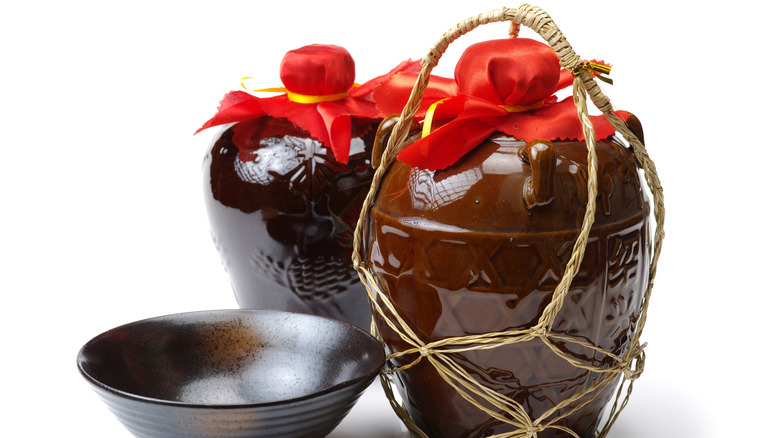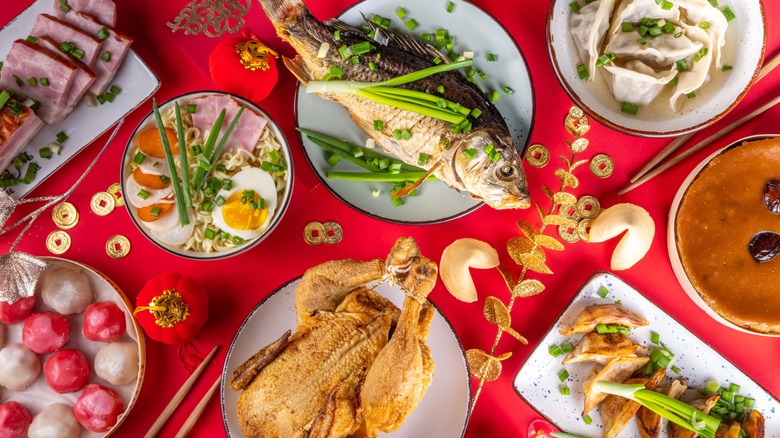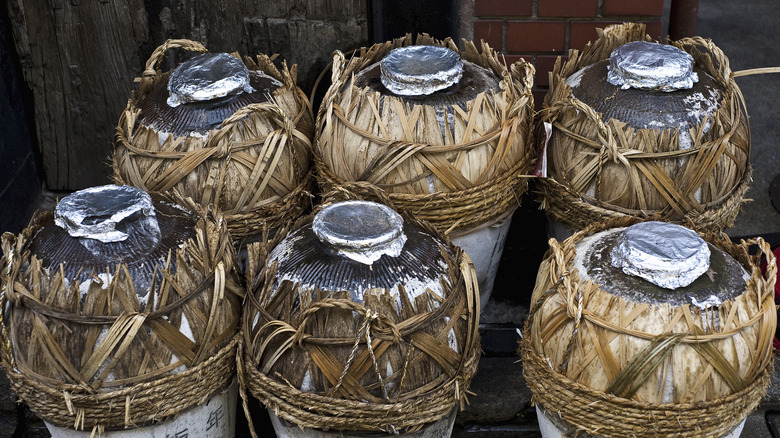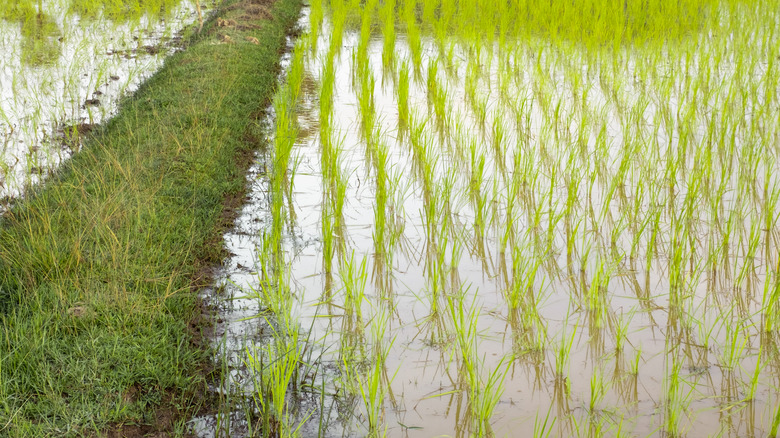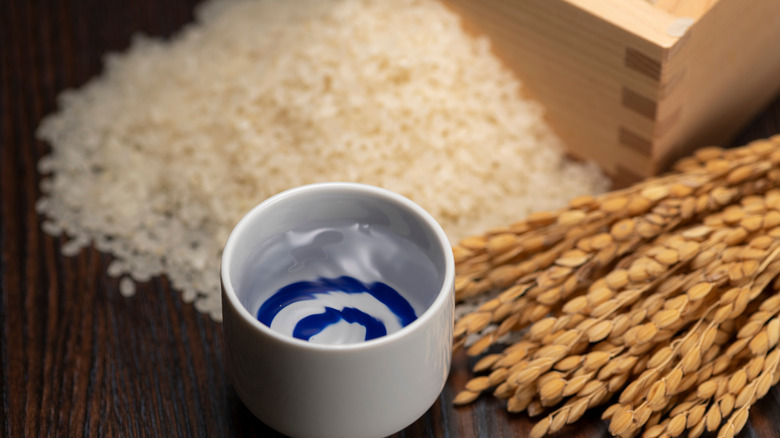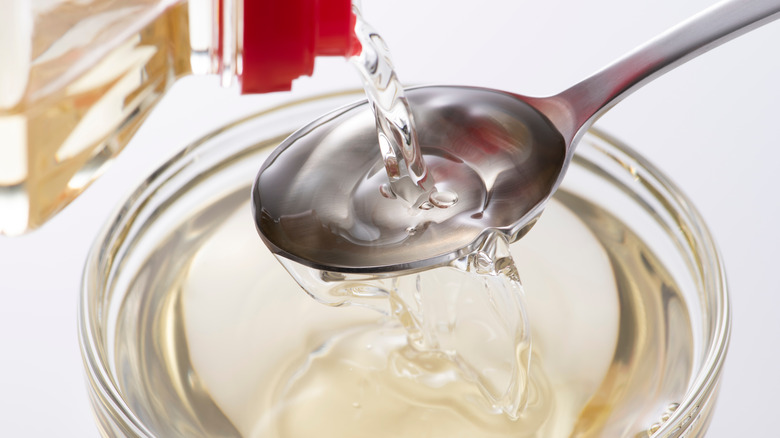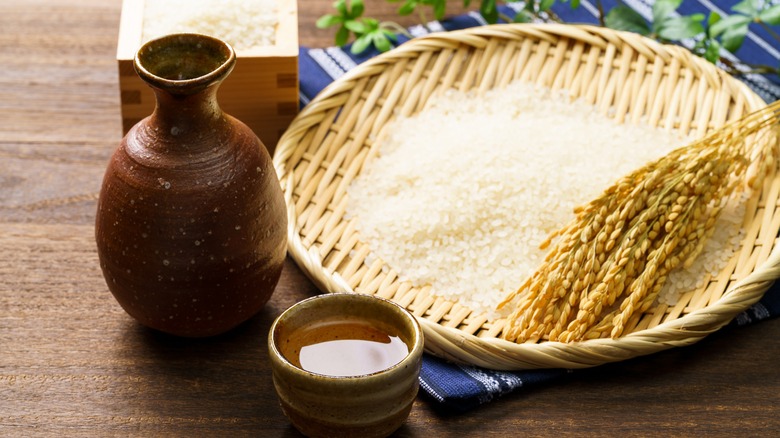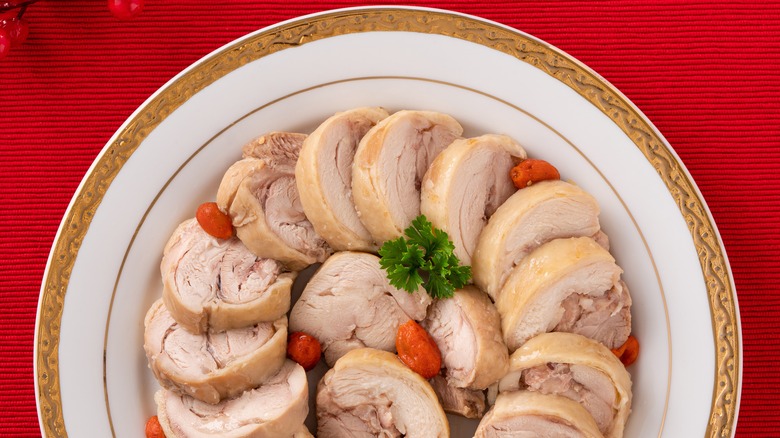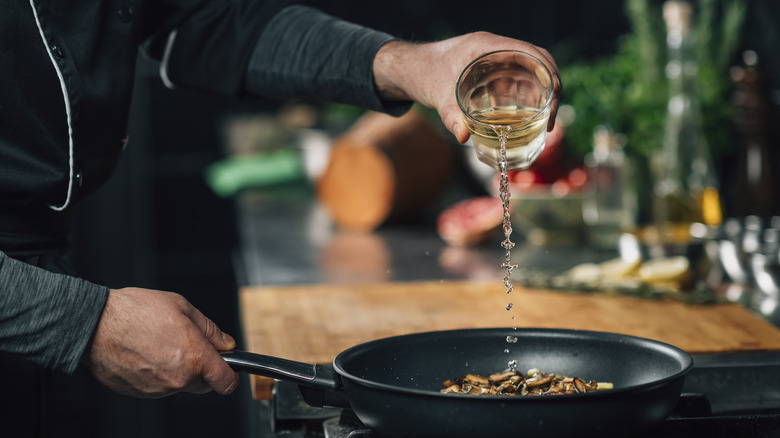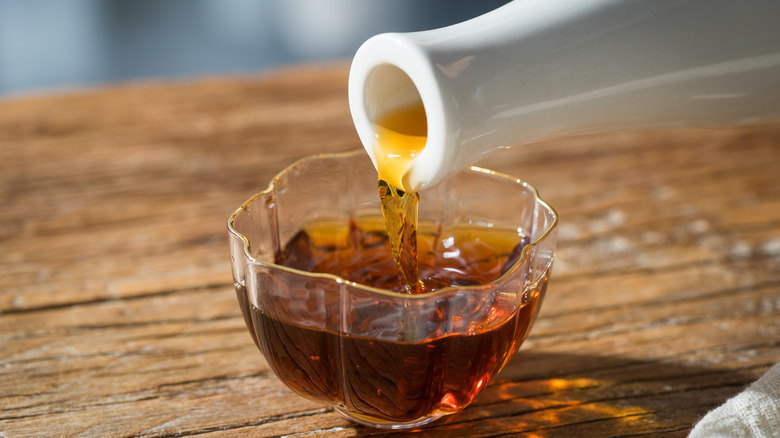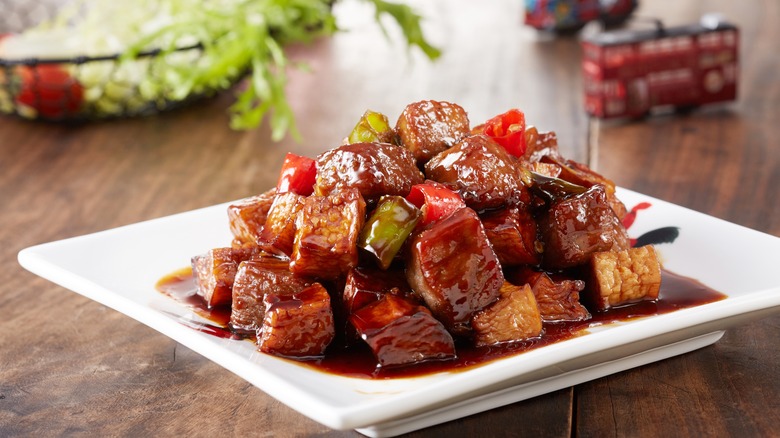13 Facts You Need To Know About Shaoxing Wine
Shaoxing wine, spelled Shaoshing or simply referred to as Chinese cooking wine, is much more than just Chinese cooking wine. This rice wine hails from China where it has been traditionally made through the process of fermentation and aging. Like with many fermented foods, specific enzymes must be introduced and mixed into the rice, and it is these enzymes that do all of the hard work. The final result is the alcoholic, tart, and vibrant Shaoxing wine that we love. Thanks to the fresh taste and savory flavor that it brings to dishes, Shaoxing wine is a necessary condiment when cooking any cuisine.
Tossing in a splash of Shaoxing wine will elevate your dishes by giving them a slightly acidic, fragrant, and bright flavor. There are countless varieties of Shaoxing wine available, and while some brands may suit you better than others, the only way to know is to try them yourself. It is worth going through the different types of Shaoxing wine because, at the end of the day, your meals will taste better. If you are not already sold on Shaoxing wine, then maybe knowing that this wine has a long history and is integral in many parts of Chinese cuisine will convince you to give it a try. Better yet, you can cook and drink Shaoxing wine, making it a multipurpose addition to your kitchen. Keep reading to learn more about this useful and delicious cooking wine that makes your Chinese food that much more irresistible.
Shaoxing wine is named after a city
Shaoxing wine is a cooking wine made from rice that originates from eastern China. In the province of Zhejiang, whose capital is Huangzhou, lies a smaller city to the south named Shaoxing. It is in this city that Shaoxing wine was originally produced and thus derived its name.
Long before modern China, the kingdom of Yue ruled over the area now known as Zhejiang. Shaoxing was a very important city in the Yue kingdom, so much so that it was the kingdom's capital during the seventh century. Since then, Shaoxing has remained important and has long been a center for agricultural products, and, of course, for Shaoxing wine. In China, rice has had a long and important history, so it is only natural that rice be used to make alcohol. The resulting rice wine is used in all realms of life from cooking to business. This unique rice wine can be distinctly tasted in many of the dishes that are famous not only in Shaoxing but all over China. Some specialty dishes that feature this famous wine include chow mein, chop suey, and drunken chicken.
Shaoxing wine is from the Zhejiang province
Shaoxing lies in the province of Zhejiang, one of China's smallest provinces. Located in the very east of China, Zhejiang borders the East China Sea and many other provinces such as Fujian, Anhui, and Jiangxi. In the past, and still today, Zhejiang province is greatly important for its strong fishing and seafood industry and is also valued for its agricultural products.
As well as being famous for its industry and modernization, Zhejiang is also very famous for its food. Its capital, Hangzhou, which surrounds the large West Lake that sits in the middle of the city, has many specialty dishes that are from West Lake and the surrounding bodies of water. For example, dishes like sweet and sour west lake fish and fried shrimp are local delicacies that can only be enjoyed in Hangzhou. Because of Shaoxing's close proximity to Hangzhou, and many other cities in the province, dishes from Zhejiang heavily represent Shaoxing wine and the savory sweetness that it brings to dishes. In fact, Zhejiang cuisine is so famous and beloved that it has been named one of the eight Chinese cuisines that are split up regionally to celebrate historical culinary differences across China.
Zhejiang is one of the eight Chinese cuisines
The eight regional Chinese cuisines were determined as a way to celebrate the vast variety of cuisines across the country. Zhejiang cuisine, also known as Zhe, is one of the eight cuisines. The other seven are Lu from Shandong, Chuan from Sichuan, Yue from Canton or Guangzhou, Su from Jiangsu, Min from Fujian, Hui from Anhui, and Xiang from Hunan.
Zhejiang cuisine earned the title of one of the eight Chinese cuisines thanks to its heavy use of seasonal vegetables and its celebration of seafood. Zhe cuisine, in which Shaoxing wine is heavily prevalent, is prized for its dishes that elevate the natural freshness and flavor of the ingredients. The overall flavor profile of Zhejiang food is light and often describes as bright. This lightness is achieved by using ultra-fresh seafood and vegetables that pair perfectly with Shaoxing wine which brings savoriness, sweetness, and a slight tang to many dishes. This tang of acidity is another reason that foods made with Shaoxing wine are often praised as balanced and refreshing. Shaoxing wine and many popular staple aromatics across China like shallots, ginger, garlic, and vinegar, come together to create the fresh and vibrant cuisine that made Zhejiang famous.
Shaoxing wine is fermented
Shaoxing wine, as the name suggests, is a type of wine. This wine is made through the process of fermentation. Fermentation, which can take on many forms in many cultures, is at its base, the introduction of bacteria to foods or substances. The bacteria then begin to break down said food and often create carbon dioxide. This carbon dioxide can be tasted, in many beverages like kvass, kombucha, and beer.
Now, back to Shaoxing wine. Another by-product of fermentation can be alcohol and that is exactly how Shaoxing wine gets its alcohol content, which is usually around 20%. In Shaoxing, the wine-making usually begins in the fall, around November. When fermenting, it is common to keep items cold unless you want the fermentation process to go very quickly. Temperature is one of the best ways to control fermentation rates because, in colder temperatures, the bacteria do not grow as prolifically. This also explains why many types of alcohol are stored in cold places like wine cellars. Shaoxing wine in particular is made by fermenting glutinous rice that has been steamed into a mash and then mixed with wheat that is been inoculated with a specific mold. This mixture then ferments until the wine takes on its signature tart taste, often featuring stone fruit and herbs undertones. The fermentation phase can last decades, but most Shaoxing wines are only fermented for a couple of years, and in some cases, only for a couple of months.
It is made from rice
Unlike grape or other fruit wines, Shaoxing wine is made from rice, like soju or sake. Rice makes Shaoxing wine light in color and also reasonably light in flavor. When sipping on Shaoxing wine, you can taste trace bits of sweetness that come from the starches in the rice. Most Shaoxing wine that you can find in the U.S. also has salt mixed in. Adding salt makes the Shaoxing wine sellable in grocery stores without a liquor license and also helps salt your dishes.
Compared to plain rice wines, Shaoxing wine brings a much deeper flavor to your dishes. This wine is fragrant with a slight sweetness that pairs well with salty and sour foods. It can be used in braises or famous dishes like drunken chicken. For drunken chicken, the chicken is cooked beforehand and then soaked in a sauce that heavily features Shaoxing wine. This final soaking stage allows the chicken to absorb the flavor of the wine, bringing a freshness to the chicken before it is served as a cold side dish. You can find this rice wine in many traditional Chinese dishes, not only those from Zhejiang, making it an essential pantry condiment.
It is not gluten-free
Although Shaoxing wine is made from rice rather than wheat or barley, it still is not entirely gluten-free. You may wonder why, so keep reading. To make Shaoxing wine, the first step is to use glutinous rice. This rice is then inoculated with a certain mold and placed in containers to ferment. However, the wheat-based mold makes the whole Shaoxing wine product not gluten-free. Therefore, while some Shaoxing wines may be made with a rice-based mold, most conventional Shaoxing wine is not gluten-free.
You can use Shaoxing wine to balance your dishes and bring a freshness that also adds layers of umami savoriness. However, if you are gluten-free, Shaoxing wine is not going to be your best friend. While this wine is essential in many Chinese dishes, some substitutes can adequately do the job. We outline some potential Shaoxing substitutes later on and explain the differences between the options.
Shaoxing is different from mirin
If you know Shaoxing wine, you may also be familiar with another type of cooking rice wine called mirin. While mirin and Shaoxing wine are both rice wines made from fermented rice, they have many differences and cannot be used in place of one another. Mirin is a Japanese cooking wine that is naturally very sweet, and almost thick. It is never consumed as just a drink and is only slightly alcoholic. The main flavor profile of mirin is sweet, and when added to dishes it brings a lovely balance to salty and sour tastes. However, because mirin is so sweet, the best substitute for it is sugar rather than Shaoxing wine.
As we have mentioned, Shaoxing wine is fragrant, slightly sweet, and a little bit herbal. It is also sometimes described as spicy because of the fresh feeling it leaves in your mouth. Based on this quick description, you can already tell how Shaoxing wine and mirin differ. On top of that, mirin is often used in small portions, as you would sugar or soy sauce. Maybe a couple of tablespoons here to sweeten your sukiyaki, or a teaspoon there for a salad dressing. On the other hand, Shaoxing wine is sometimes used in large quantities and can make up the bulk of a broth or cooking liquid. Therefore, if you are looking for a substitute for Shaoxing wine, look elsewhere, because mirin is not it.
You can drink Shaoxing wine
When Shaoxing wine has aged, it becomes exactly what you might imagine — wine. However, there are wide varieties of Shaoxing wine which all have varying degrees of quality. As with many alcoholic drinks, it is possible to find Shaoxing wine that is purely used for cooking, or Shaoxing wine that is fruity, rich, and light, perfect for drinking neat. Many cooking Shaoxing wines are salted and not for drinking because of their lower quality and salt content. However, like many cooking wines, think sake and pinot grigio, you can hit two birds with one stone by both drinking and cooking with high-quality Shaoxing wine.
It is estimated that Shaoxing wine was created around 475 BCE (via CITS), and while it went through different phases of popularity since then, it remains a staple in Chinese cuisine and culture today. During the Qing Dynasty, it would have been strange to find a party or feast that did not feature Shaoxing wine. In China today, it is common for Shaoxing wine to be enjoyed at fancy or important events, yet this appreciation for Shaoxing wine as a beverage has yet to bloom in the U.S. Some Shaoxing wine artisanal brewers are trying to revive the age-old art of producing Shaoxing wine, and it is from their effort and the growing awareness of this wonderful rice wine that Shaoxing wine is becoming more and more beloved and respected as both a cooking ingredient and beverage.
Shaoxing wine is sweet and spicy
Shaoxing wine is often described as slightly sweet, with an almost spicy afternote. That spiciness is most likely the reason that this wine is also often used in the same manner as vinegar and other forms of acid. It brings a depth of umami flavor to your dishes, but also balances them incredibly well thanks to this spiciness and freshness. You can use Shaoxing wine in hot and cold dishes, such as drunken chicken where the chicken is soaked in a Shaoxing wine marinade after it is cooked.
Shaoxing wine's flavor and color also play a large role in Chinese dishes that are often served during Lunar New Year. The sweetness from this tart, dry wine, balances and elevates the natural flavors in many ingredients. It also shines on its own when used in salad dressings and marinades. In terms of color, the red amber color of Shaoxing wine is also partially to thank for many of the red dishes that appear at the Lunar New Year table. It is from a combination of Shaoxing wine, garlic, ginger, soy sauce, and many other condiments and techniques that we can enjoy many of our favorite sweet, salty, and sour Chinese dishes.
It adds umami
When you make risotto, using white wine is one of the best ways to bring out the umami of the cheese and rice. Using Shaoxing wine is no different. Adding Shaoxing wine to your dishes will bring a delightful depth to all of them which is also known as umami, the fifth taste of savoriness. Whether you are braising pork knuckles, or stir-frying pea shoots, Shaoxing wine balances dishes in a way that almost acts like vinegar and wine.
Part of the reason Shaoxing wine is so umami is thanks to its many amino acids. Shaoxing wine contains many amino acids of a wide variety, and when these interact with other tastes like salt and sugar, they can transform a dish into the savory deliciousness that we all love. Amino acids are important for developing the taste of umami because many of them, such as the famous glutamate, are responsible for creating an umami taste. Therefore, high levels of amino acids in Shaoxing wine contribute heavily to the comforting savory flavor that Shaoxing wine dishes have.
It is golden in color
Shaoxing wine comes in a variety of shades and flavors and when you are picking out the brand that you like best, make sure to try it in dishes and on its own to ensure that the flavor is exactly what you want. This cooking wine, which is mostly made from rice, does not actually look like it is distilled from white grains. Unlike sake, which is usually clear or milky white, Shaoxing wine is amber-colored. Sometimes you can even find Shaoxing wine that is darker, closer to a golden brown, or a deep red. Whatever type of Shaoxing wine you find though, it should be colored. Unlike plain rice wines or cooking wines, Shaoxing wine is expected to have a color.
Shaoxing wine that is made for drinking rather than cooking sometimes has additional items in it that also contribute to the color. For example, you may be able to find Shaoxing wine that has plums soaking in it. This allows the wine to absorb the fruity, tart flavor of the plums and also turn an even darker red thanks to the pigment in the plum skin. Other ways to you may be able to find Shaoxing wine is with rock sugar or tangerine peels.
Shaoxing wine is essential in Chinese cooking
Shaoxing wine is a must-have when cooking authentic tasting Chinese food. Even if you are cooking a dinner inspired by Yunnan, there is a high chance that one of the dishes will call for this famous rice wine. It is an essential condiment in any pantry and can serve as a very multipurpose condiment. You can use it as you would white wine or sake when cooking things like grains, fish, and red meat.
You can also use Shaoxing wine as vinegar. It is often heavily used as a main ingredient in sauces and braises such as in the recipe for red braised pork belly where the braise derives much of its flavor from Shaoxing wine. Also, the natural tartness of this wine along with its fresh flavor makes it a wonderful addition to both warm and hot dishes. It will balance many foods that are oily, sweet, or salty, and can bring a lightness to any bite.
In a pinch, use sherry
While Shaoxing wine is essential for countless reasons, it is not always accessible in grocery stores or you may need a gluten-free option. If for whatever reason you are looking for a Shaoxing wine substitute, you can opt for another dry wine such as sherry. Sherry, which is different from port, is a fortified and aged wine that is often a mix of many wines, some old and some young.
Like with Shaoxing wine, when cooking with sherry, the alcohol simmers off and leaves behind a nutty savory flavor from the wine. Therefore, if you are looking for Shaoxing wine substitutes, this is the best place to start. But, if you do choose to use sherry as a Shaoxing wine substitute, make sure to select a dry sherry, because one that is too sweet will disrupt the balance of your dish. Other Shaoxing wine substitutes include mirin and sake. We went over the differences between mirin and Shaoxing wine earlier, so it should come as no surprise that if you do use mirin as a substitute you must dilute it using something acidic like lemon juice or vinegar. Other cooking rice wines, like sake, are also good substitutes and may be easier to find than Shaoxing wine.
Static Media owns and operates Tasting Table and Mashed.
